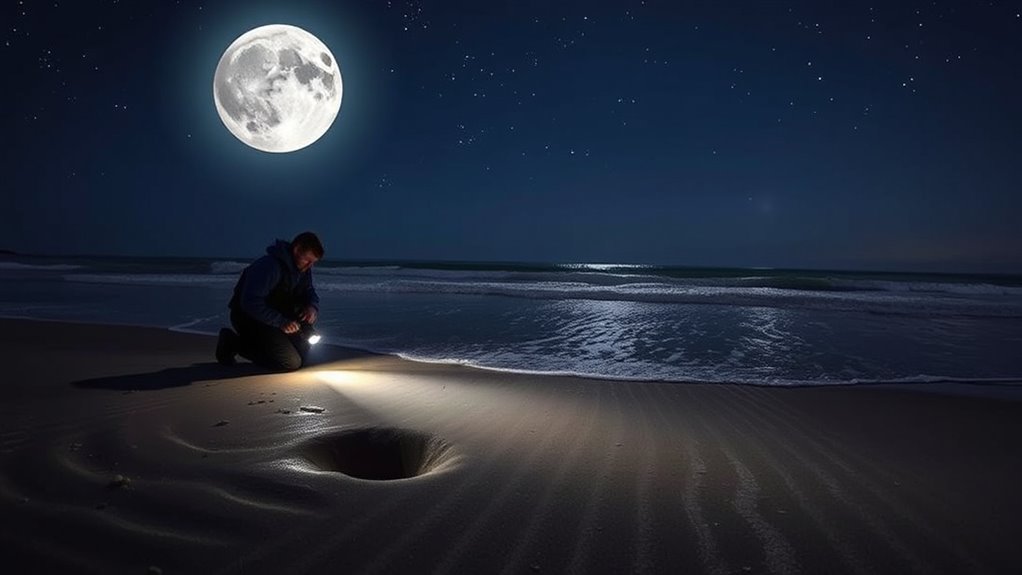To maximize your razor clam yields, master the moon phases and plan around spring tides during new and full moons when water levels change dramatically. These are prime times when clams surface during low tides, making them easier to find and extract. Keep track of lunar cycles and tide schedules to hit the best windows. Staying strategic with moon phases boosts your success, and if you continue exploring, you’ll discover even more tips to become a clam-hunting expert.
Key Takeaways
- Schedule hunts during new or full moons to align with spring tides, which create the largest water level fluctuations.
- Plan your clam digging trips around low tide periods during spring tides for optimal access to clam beds.
- Track lunar phases using a lunar calendar to anticipate favorable tide conditions for monster-sized clams.
- Recognize that clams are more active and accessible during low tides, especially when coinciding with specific moon phases.
- Use knowledge of moon-tide cycles to strategize and maximize your clam yields consistently.

Have you ever wondered how understanding the lunar cycle can enhance your life? When it comes to clam digging, especially for those monster yields, knowing the intricacies of tides and moon cycles can make all the difference. The moon exerts a powerful influence on the tides, and these fluctuations directly impact clam behavior patterns. During certain moon phases, tides reach their lowest points, exposing the clam beds and making it easier for you to access them. Conversely, when the tides are high, clams retreat deeper into the sand, making your efforts less effective. By tracking these cycles, you can time your hunt to coincide with ideal conditions, increasing your chances of a successful haul.
Clams are highly responsive to the ebb and flow of tides, which are driven by the moon’s gravitational pull. As the moon waxes and wanes, it causes the sea level to rise and fall in predictable patterns. When the moon is new or full, the gravitational pull is strongest, resulting in spring tides—these bring the most dramatic changes in water levels. During these times, low tides are especially low, exposing large sections of clam beds. This is when clams are most accessible because they tend to migrate closer to the surface to feed and respire during low tide periods. Knowing these patterns allows you to plan your hunts during these windows, giving you a strategic advantage over other clam diggers who might go out blindly.
Clams are most accessible during spring tides when they surface to feed.
In addition to tides, understanding clam behavior patterns is essential. Clams tend to follow a daily rhythm influenced by the moon phases, often burrowing deeper or surfacing depending on the time of day and tide levels. During low tide, especially in the early morning or late evening, clams are more likely to be near the surface, making them easier targets. As the tide rises, they burrow deeper to avoid the incoming water, making them harder to find. Recognizing the importance of high-quality tools can further improve your success, as proper equipment helps you access and extract clams efficiently. By observing these natural tendencies and aligning your clam digging schedule with the lunar cycle, you maximize your chances of finding monster-sized clams.
Timing your hunt according to the moon phase isn’t just about luck; it’s about strategy. Keep a lunar calendar handy, note the upcoming spring tides, and plan your trips accordingly. The more you understand the relationship between tides, moon cycles, and clam behavior patterns, the more precise and productive your hunts will become. Mastering these details transforms clam digging from a gamble into a well-informed pursuit, ensuring you walk away with impressive catches every time.
Frequently Asked Questions
What Is the Best Moon Phase for Beginner Clam Hunters?
If you’re a beginner clam hunter, the best moon phase to start with is a new moon or a new moon phase, as these often offer the best conditions. During this time, the tides are lower, making it easier to find and dig for razor clams. Use beginner tips like checking local tide charts and going during low tide to increase your chances of success.
How Do Weather Conditions Influence Clam Activity During Different Moon Phases?
Imagine a gentle breeze guiding you to the shore’s secrets. Weather patterns and water temperature play behind the scenes, quietly influencing clam activity. Calmer weather and stable water temps encourage clams to surface, making your hunt more fruitful. Storms or fluctuating temperatures can send them hiding, reducing your chances. By monitoring these conditions, you can better anticipate clam behavior, turning your hunt into a more successful and rewarding adventure.
Are Specific Tidal Heights More Favorable for Monster Clam Encounters?
You should focus on specific tidal heights that bring razor clams closer to the surface, increasing your chances of a monster encounter. When the tide is at a mid to low height, clam depth decreases, making them easier to spot and dig up. During these times, clams tend to be more active near the surface, so plan your hunt around these tidal conditions to maximize your chances of finding those monster-sized razor clams.
Can Moon Phases Affect Clam Depth and Burrowing Behavior?
Ever wondered how moon phases impact clam behavior? The lunar influence markedly affects their depth and burrowing habits. During full moons, clams tend to stay deeper or burrow more thoroughly, reducing your chances of a quick catch. Conversely, new moons boost their nocturnal activity, making them surface or burrow less deeply. By understanding these patterns, you can plan your hunt around moon phases for better success.
How Long Should I Wait Between Hunts During Different Moon Cycles?
You should wait at least a few days between hunts to observe clam migration patterns and allow the population to recover. During different moon cycles, clams may burrow deeper or surface more often, affecting your success. The ideal wait time varies but generally ranges from three to seven days, giving clams enough time to resurface and ensuring sustainable harvesting. This approach maximizes your yield while respecting the ecosystem.
Conclusion
So, next time you plan your razor clam hunt, remember the moon’s subtle influence. It’s funny how, just as the tides align perfectly, you stumble upon that prime spot or catch a monster clam. The moon’s phases seem to guide your luck, almost like a secret partner in your adventure. Keep an eye on the lunar cycle, and you might just find yourself reeling in the biggest, most unexpected prize—proof that coincidence and timing really do go hand in hand.










